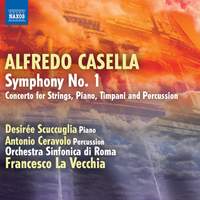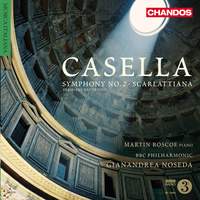Recording of the Week,
Alfredo Casella
If someone had asked me a few weeks ago to name an early twentieth century Italian composer of symphonies, I have to admit I would have struggled. Italy at the time was very much in the grip of opera, with Puccini just the latest star, following on from the previous century of Rossini, Donizetti, Verdi and others. Through opera Italy really did lead Europe (and the world) and in Italy it was viewed somewhat unfashionable for a composer to write orchestral or chamber music. That said there was a new generation just starting to emerge – a generation born in the 1880s – which included Respighi, Pizzetti, Malipiero and the subject of today’s newsletter - Alfredo Casella.
On the advice of Giuseppe Martucci the 13-year-old Casella went from Turin to Paris to study piano and composition at the Paris Conservatoire. In the class of Gabriel Fauré he could count Enescu and Ravel amongst his fellow students. He knew Debussy, Stravinsky and Falla, and also came into contact with Mahler and Strauss. Over the next two decades Paris became the musical capital of the world and it was a great place for a young composer to be.

Why two different record labels have suddenly decided it is time to re-explore the music of Casella is presumably a co-incidence, but from what I have heard over the past couple of weeks, it is well overdue. Naxos have started a four-disc cycle with a disc containing his First Symphony and his Concerto for Piano, Strings, Timpani and Percussion, while Chandos continue their more general ‘Musica Italiana’ series with the BBC Philharmonic under Gianandrea Noseda with a recording of Casella’s Second Symphony and Scarlattiana.
Casella was just 22 when he completed his First Symphony and at 45 minutes long it is a significant work. Cast in three movements you might class it as French in design (César Franck had really established the three movement pattern), but in sound world you can hear everything from Tchaikovsky and Rimsky Korsakov to Mahler, Strauss and Wagner. You can also hear echoes of composers and works yet to be written with the film music of John Williams just one such association. That said, Casella’s writing clearly has its own distinctive identity with imaginative orchestration, dark sonorities and a lovely slow movement.
The Second Symphony was written just three years after the first but already shows a much greater refinement of style and coherent individual voice. Again themes, harmonic colours and orchestral sounds show similarities to Mahler and other composers, but Casella shows his great ability to build the excitement in the music towards a genuine frenzy. The playing of the BBC Philharmonic is excellent and there is a huge amount to enjoy here.
I’ve put extracts from both symphonies on the website to give you an idea, and I think it is wonderful that there are still works like these being discovered and recorded for the first time.
Available Formats: CD, MP3, FLAC
Available Formats: CD, MP3, FLAC, Hi-Res FLAC




